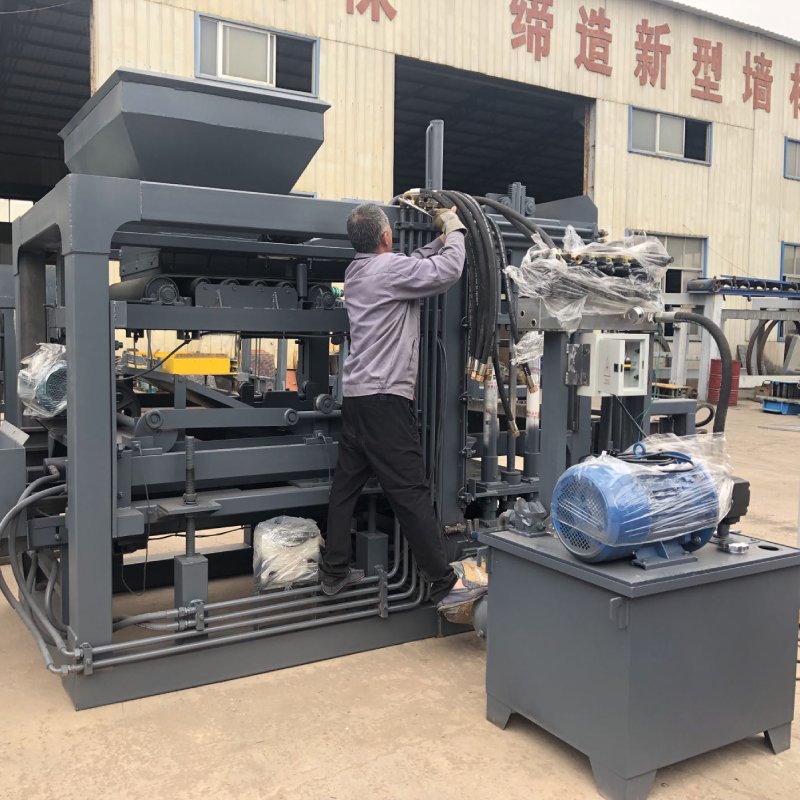
Image source Aiwei Block Machine
Boosting Efficiency with High-Performance Block Brick Making Machines
The construction industry is a cornerstone of human progress, responsible for creating the world’s most iconic structures. A crucial component of this industry is brick production, an age-old craft that has undergone significant transformation. Today, high-performance block brick making machines are leading the charge in enhancing construction efficiency, productivity, and sustainability. In this comprehensive article, we will delve into the world of high-performance block brick making machines, exploring their significance, capabilities, and how they are boosting efficiency across the construction sector.
Chapter 1: The Role of Bricks in Construction
Before we delve into the world of high-performance brick making machines, it’s essential to understand the significance of bricks in construction.
1.1 The Timeless Legacy of Bricks
- Historical Roots: Bricks have been a primary construction material for millennia, dating back to ancient civilizations like the Sumerians and Egyptians.
- Versatility: Bricks are incredibly versatile, suitable for a wide range of construction applications, from structural walls to decorative facades.
- Durability: Well-manufactured bricks can endure for centuries, ensuring the longevity of structures.
- Thermal Properties: Bricks offer excellent thermal insulation, contributing to energy efficiency in buildings.
1.2 Evolution of Brick Production
- Manual Brick-Making: Historically, bricks were molded and dried by hand, a labor-intensive process.
- Fired Bricks: The advent of kilns allowed for the production of fired bricks, which were more durable and weather-resistant.
Chapter 2: The Birth of High-Performance Brick Making Machines
The Industrial Revolution marked a turning point in brick production, giving rise to the first brick-making machines.
2.1 Early Brick-Making Machines
- Manual Operation: Early machines were manually operated but significantly increased brick production rates compared to handcrafting.
- Advancements in Power: Steam power and later, electric motors, transformed brick manufacturing.
2.2 Benefits of Machine-Made Bricks
- Consistency: Machine-made bricks are uniform in size and shape, enhancing structural integrity.
- Mass Production: Brick-making machines allowed for mass production, making bricks more accessible and affordable.
Chapter 3: Modern High-Performance Block Brick Making Machines
In this chapter, we explore the characteristics and capabilities of modern high-performance block brick making machines.
3.1 Automation and Efficiency
- Fully Automated Machines: These machines require minimal human intervention, leading to high production rates and efficiency.
- Semi-Automatic Machines: Combining automation and manual operation, these machines offer a balance between efficiency and flexibility.
3.2 Advanced Molding and Compression
- High-Pressure Compression: Modern machines employ high-pressure techniques to create bricks with superior strength and durability.
- Customization: Some machines allow for the customization of brick sizes and designs to meet specific project requirements.
3.3 Sustainable Features
- Recycled Materials: Innovative machines can produce bricks from recycled materials like fly ash, slag, and even plastic waste.
- Energy Efficiency: Many modern machines are designed to be energy-efficient, reducing their environmental impact.
Chapter 4: The Impact on Construction Efficiency
High-performance block brick making machines play a pivotal role in boosting construction efficiency.
4.1 Shorter Timelines
- Rapid Brick Production: High-performance machines significantly increase brick production rates, reducing project timelines.
- Just-in-Time Production: Bricks can be produced on-demand, eliminating the need for large brick stockpiles.
4.2 Reduced Labor Costs
- Automation: Automated machines require fewer operators, leading to substantial labor cost savings.
- Skilled Labor: Skilled labor is not as critical in machine-based brick production, further reducing labor expenses.
4.3 Enhanced Quality and Consistency
- Structural Integrity: Machine-made bricks are consistent in size and shape, ensuring uniformity in construction, which enhances structural integrity.
- Reduced Waste: Machines generate less waste during brick production, contributing to cost savings.
Chapter 5: Sustainability and Environmental Impact
High-performance block brick making machines align with the growing emphasis on sustainability in the construction industry.
5.1 Reduced Carbon Footprint
- Energy Efficiency: Reduced energy consumption in brick production leads to a lower carbon footprint.
- Recycled Materials: Using recycled materials in brick making reduces the environmental impact.
5.2 Resource Conservation
- Efficient Resource Use: Modern machines use resources more efficiently, reducing the depletion of natural materials.
- Less Soil Erosion: Sustainable brick production methods mitigate soil erosion, contributing to ecosystem preservation.
Chapter 6: Future Trends and Innovations
The evolution of high-performance brick making machines continues, with promising trends and innovations on the horizon.
6.1 3D Printing Technology
- 3D Printed Bricks: 3D printing technology is being applied to brick making, allowing for intricate and customized designs.
- On-Site Printing: The potential for on-site 3D printing of bricks could revolutionize construction practices.
6.2 Robotics and Automation
- Robotic Bricklayers: Robots are being developed to lay bricks with precision and speed, further reducing labor costs.
6.3 Biodegradable Bricks
- Biodegradable Materials: Researchers are exploring the use of biodegradable materials for brick production, offering an eco-friendly alternative.
Chapter 7: Challenges and Considerations
While high-performance block brick making machines offer numerous benefits, there are challenges and considerations to address.
7.1 Initial Investment
- Cost of Machines: High-quality high-performance machines can have a higher initial investment.
7.2 Skills and Training
- Operator Training: Operators require training to operate and maintain advanced machines effectively.
7.3 Regulatory Compliance
- Environmental Regulations: As sustainability gains prominence, regulations governing brick production may become more stringent.
Chapter 8: Conclusion
High-performance block brick making machines are not merely technological marvels; they are the driving force behind a more efficient, sustainable, and productive construction industry. From reducing construction timelines and labor costs to enhancing the quality of bricks and minimizing the environmental footprint, these machines are the embodiment of progress. As the construction industry continues to evolve, high-performance brick making machines will undoubtedly play an ever-expanding role in shaping a future where efficient, sustainable, and high-quality construction is the norm. The future of construction is being built one high-performance brick at a time.
